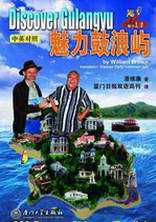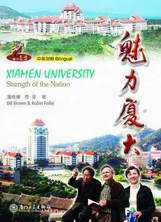![]() Click
to
Access
Click
to
Access
OUTSIDE China
![]() Click
to Access
Click
to Access
INSIDE
China ![]()
TRAVEL LINKS
![]() Xiamen
Xiamen
![]() Gulangyu
Gulangyu
![]() Jimei
Jimei
![]() Tong'an
Tong'an
![]() Jinmen
Jinmen
![]() Zhangzhou
Zhangzhou
![]() Quanzhou
Quanzhou
![]() Wuyi
Wuyi
![]() #1Fujian
Sites!
#1Fujian
Sites!
![]() Fujian
Foto Album
Fujian
Foto Album
![]() Books
on Fujian
Books
on Fujian
![]() Readers'Letters
Readers'Letters
![]() Ningde
Ningde
![]() Zhouning
Zhouning
![]() Longyan
Longyan
![]() Sanming
Sanming
![]() Putian
Putian
![]() Bridges
Bridges
![]() Travel
Info,
Travel
Info,
![]() Hakka
Roundhouses
Hakka
Roundhouses
![]() Travel
Agents
Travel
Agents
MISC. LINKS
![]() Amoy
People!
Amoy
People! ![]()
![]() Darwin
Driving
Darwin
Driving ![]()
![]() Amoy
Tigers
Amoy
Tigers
![]() Chinese
Inventions
Chinese
Inventions
![]() Tibet
in 80 Days!
Tibet
in 80 Days!![]()
![]() Dethroned!
Dethroned!
![]()
![]() Misc.Writings
Misc.Writings
![]() Latest
News
Latest
News
![]() Lord
of Opium
Lord
of Opium
![]() Back
to Main Page
Back
to Main Page
![]() Order
Books
Order
Books![]() Xiamenguide
Forum
Xiamenguide
Forum 
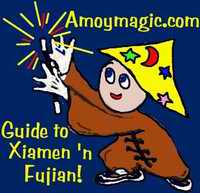
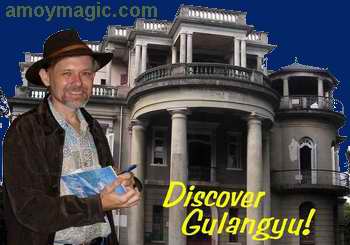 almost
400 pages, bilingual Chinese/English,B&W and color photos, drawings,
maps. Buy Online or in Xiamen
bookstores.
almost
400 pages, bilingual Chinese/English,B&W and color photos, drawings,
maps. Buy Online or in Xiamen
bookstores.
Gulangyu's
Pioneer Educators (excerpts)
![]() Gulangyu
Main Page
Gulangyu
Main Page
![]() Chinese
Version
Chinese
Version
![]() Scholar
Bureaucrats
Scholar
Bureaucrats ![]() Educational
Reform
Educational
Reform
![]() Pioneering
Women's Education
Pioneering
Women's Education
![]() John
Ma--Pioneer Coach of Modern Chinese Sports
John
Ma--Pioneer Coach of Modern Chinese Sports
![]() 7th
Day Adventists Sino-American School
7th
Day Adventists Sino-American School ![]() Sage
of Singapore (Lin Wenqing)
Sage
of Singapore (Lin Wenqing)
![]() Lu
Zhuangzhang--Father of Pinyin
Lu
Zhuangzhang--Father of Pinyin ![]() "Pinyin
Path"
"Pinyin
Path"
 Lifelong
Imperial Exams
Lifelong
Imperial Exams
"Failure to obtain a coveted prize never baffles or
discourages the indefatigable competitor. In some cases the contest continues
a lifetime with the prize never won. For example, at a single prefecture
10,000 candidates presented themselves, under the old regime, at the regular
examination. Among them were found the grandfathers, sons, and grandsons,
all competing for the same prize, i.e., the same degree. In 1889 the Governor
General of Fukien reported that at the au-tumnal examination in Foochow
there were nine candidates over eighty, and one over ninety years old.
At still another, thirty five competitors were over eighty and eighteen
over ninety. Such indomitable perseverance along educational lines...has
been seldom witnessed outside of China. If ever her educational methods
conform to Western ideas...Chinese scholarship is destined to take first
rank. Rev. Philip Wilson Pitcher, “In and about Amoy,” 1912,
p.84
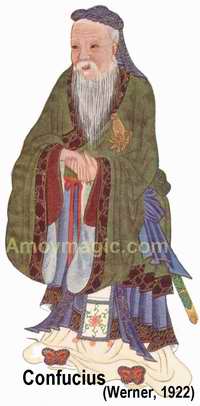
Scholar Bureaucrats For 1500 years, Chinese scholars prepared for government office by memorizing Confucian classics and composing literary treatises and couplets. But eventually Chinese realized that survival on our shrinking planet required revamping the 1500-year-old Confucian system that churned out what Chairman Mao called “scholar bureaucrats.” And few places had greater impact on modern Chinese education than the tiny islet of Gulangyu.
Gulangyu has produced not only
dozens of famous musicians but also internationally famous folk like the
writer “Lin Yutang”, the artist Teng Hiok Chiu (Zhou Tingxu),
the astronomer Yu Qingsong (1897-1978), and China’s first modern
sports coach and athletics pioneer John Ma. Gulangyu’s trailblazing
in women’s education helped birth talents like pioneering obstetrician
Madame Lin Qiaozhi.
Back to top
Educational reform
began with 19th century Protestant missionaries on Gu-langyu, who opened
about 20 different schools—everything from China’s first kindergartens
to vocational schools and colleges. Gulangyu hosted China’s first
day-school, started in 1845 by Rev. Lyman Burt Peet. William Young opened
Fujian’s 1st school for girls about the same time.
 The
London Missionary Society established Fujian’s first
seminary, “Holy College”, and some of Gulangyu’s earliest
primary and middle schools, “Fumin Primary School” and “Chengbi
Middle School”. While Chinese schools’ materials were edited
and published by the Chinese Educational Bureau, Christian schools wrote
their own materials. The American Reformed Mission’s popular “3
Charac-ter Christian Primer” suggested their primary goal was evangelism,
not education, but even Chinese officials admitted these programs helped
revitalize Chinese education.
The
London Missionary Society established Fujian’s first
seminary, “Holy College”, and some of Gulangyu’s earliest
primary and middle schools, “Fumin Primary School” and “Chengbi
Middle School”. While Chinese schools’ materials were edited
and published by the Chinese Educational Bureau, Christian schools wrote
their own materials. The American Reformed Mission’s popular “3
Charac-ter Christian Primer” suggested their primary goal was evangelism,
not education, but even Chinese officials admitted these programs helped
revitalize Chinese education.

Gulangyu Huaide Kindergarten, one
of the first in China, was built in early 1898 at the site of present-day
Sunlight Kindergarten (Riguang You’er Yuan). Two middle schools
opened on Gulangyu in 1881 were joined in 1907 to form the Union Middle
School of the three Missions. [ Gulangyu’s Christian missions were
virtually unique in China in their close cooperation in evangelism, church
building, and education—often in the face of stiff opposition by
denominational leaders in their home countries. Their example set the
stage for indige-nous Chinese churches’ rejection of denominational
molds.]
Gulangyu Yangyuan Primary
School was founded in 1889 in Xiamen and
moved to Gulangyu in 1929. Famous alumni included writer Lin Yutang and
astronomer Yu Qingsong.
Back to top
The Tung-Wen Institute was started
on Gulangyu in 1898 by Mr. A. Burlin-game Johnson, then U.S. Consul at
Amoy, and relocated to larger facilities on Amoy Island in 1902. Wealthy
Chinese funded the school and formed the Board of Trustees, the president
of which was the resident U.S. Consul.
The Weizheng Elementary School,
near the Catholic Church, was established by Ma Shouren in 1912, and after
Liberation renamed Longtou School and merged into Lujiao School. 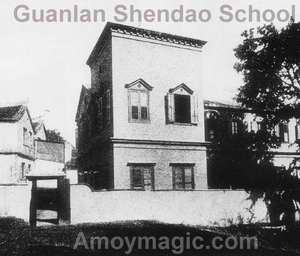
The Fumin Vocational School, founded
in 1921 by Ye Guxu and others within Fumin Primary School, is now Gulangyu’s
Bishan Primary School. It was expanded in 1925 and renamed “South
Fujian Vocational School”, but closed after the Japanese invaded
Xiamen in 1938.
U.S. and British church affiliated schools were suspended from 1942 until
the Japanese’ defeat. English and Christian lessons were forbidden,
and students were forced to learn Japanese and Mahayana Buddhism. After
1949, the gov-ernment took over church-run schools. In 1952, Tianwei Women’s
College became the “Adjunct Primary School of Xiamen Normal School”.
In 1960 it was renamed “No.1 Central Primary School”and today
it is the “People’s Primary School”. The school buildings
at #18 Tianwei Road are the Xiamen Gulangyu Officer’s Rest Home’s
dining room.
Back to top

Pioneering Women’s
Education China had few female students
and only 3 women’s colleges when the American Reformed Mission opened
its first primary school in Xiamen’s Liaozihou in 1845 and “Amoy
Women’s College” in 1847; this class of 12 girls debuted Fujian
women’s education. The first president, Maria Talmage, was the younger
daughter of missionary John Van Nest Talmage, who served in Xiamen for
over 40 years. 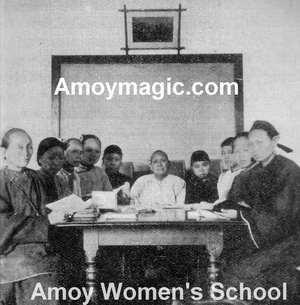
The women’s college burned down in 1880 and was relocated to Tianwei
and named “Tianwei Women’s College,” or “Huaqi
Women’s School”. Soon afterwards, the Tianwei Women’s
college established the school which in 1921 became “Yude Middle
School.” When Xunyuan Middle School relocated to Zhangzhou in 1925,
Yude took over their premises on Dongshanziding. By 1934, Yude had 299
female primary and 254 middle school students. While Yude is no more,
its legacy continues in overseas Chinese communities in such countries
as the Philippines.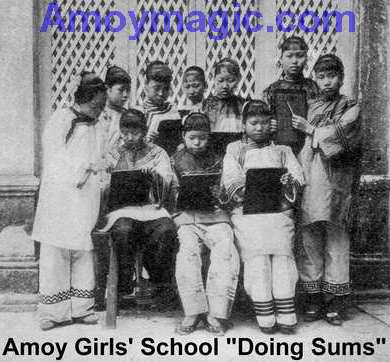
Back to top
John Ma (Ma Yuehan) Pioneer Coach of Modern Chinese Sports
Given Mao Zedong’s lifelong preoccupation with health (he was 72 when he swam two miles across the Yangtze!), Mao must have really appreciated Gulangyu native Ma Yuehan, China’s 1st athletics coach and pioneer in sports.
Mao Zedong
on Sports
“In the educational system of our country, required courses are
as thick as the hairs on a cow”… [but] Children become ill,
or even die young, be-cause of studying… Students feel that exercise
is shameful. According to my humble observation, this is really their
major reason for disliking ex-ercise. Flowing 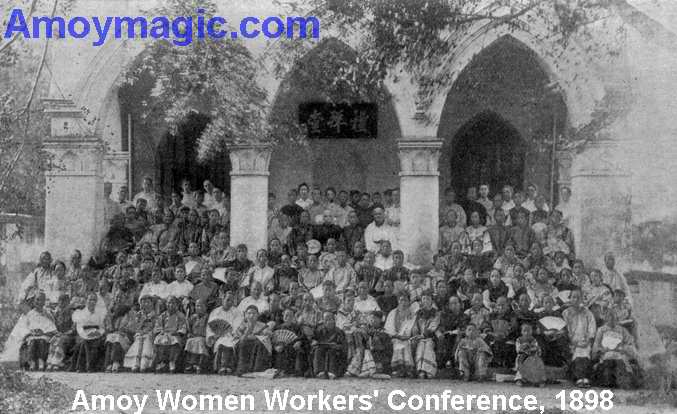 garments,
a slow gait, a grave, calm gaze — these constitute a fine deportment,
respected by society. Why should one sud-denly extend an arm or expose
a leg, stretch and bend down? Is this not strange?” Mao Zedong,
“A Study of Physical Education.” 1917
garments,
a slow gait, a grave, calm gaze — these constitute a fine deportment,
respected by society. Why should one sud-denly extend an arm or expose
a leg, stretch and bend down? Is this not strange?” Mao Zedong,
“A Study of Physical Education.” 1917
John Ma (1882-1966) lived at #58 Zhangzhou Road, and led
a tough life with his elder brother after losing his mother at age 5 and
his father at age 7. When John was 13, friends and relatives helped him
enter “Fumin Elementary School. When he was 22 he entered preparatory
classes in Shang-hai’s St. John’s University and received
a degree in medicine at age 29.
Back to top
Young John’s swimming, and climbing Gulangyu’s rocky peaks,
gave him the physique to dominate the schools’ soccer, swimming,
tennis, baseball and track and field teams. He also had a strong will,
as he showed in the Shanghai Y.M.C.A.’s “International Track
and Field Sports Meet” . Angered by a haughty Japanese who was always
a dozen yards ahead of him, Ma gave it everything he had and won the race,
beating the Japanese by 50 yards.
Ma’s degree was in medicine but he felt prevention, not cure, was
the key to health, so he entered physical education. After studying in
the U.S. he suc-ceeded an American as Tsinghua University’s P.E.
director and led his students to 20 national track and field records—surpassing
the former American’s record. But university president Luo Jialun
saw no need for a “professor of fun and games” and demoted
Ma from professor to coach.
Ma was undaunted. The next year, the Tsinghua Soccer Team
won the championship in the North China Soccer Match. The team re-turned
home, ecstatic students carried John Ma onto the Tsinghua campus, and
after the celebration President Luo reinstated Ma as a professor.
Many people tried to persuade Ma to leave Beijing just before Liberation
but he said, “No matter what party or society we have, P.E. is necessary.”
Ma stayed at Tsinghua, and many followed his example. Ma promoted Chinese
ath-letics right up until his death in 1966, and his family has carried
on his work.
John Ma’s son Ma Qiwei, a champion volleyball player, was the dean
of Beijing Sports College. Ma’s son-in-law Mu Zuoyun played on the
national basketball team, took part in the Berlin Olympic Games in 1935,
and was a longtime chairman of the China Basketball Association.
Back to top

Lu Zhuangzhang--Father of Pinyin
“If characters don’t perish, China must perish!” Lu Xun, 1936
Lu Zhuangzhang, Father of Pinyin & Punctuation Ever
since Jesuit missionary Matteo Ricci published “Miracle of Western
Letters” (Xizi Qiji) in 1605, scholars have debated Chinese char-acters’
future. Fang Yizhi (1611-1671) and others complained they were too numerous
and too complicated. But change in tradition-bound China was more complicated
than characters, and 200 years passed before any serious attempt at reform.
Song Shu (1862-1910 ) bemoaned China’s high rate of illiteracy,
especially for women (he estimated only 1 in 40,000 women could read!).
Song Shu wrote:
“With so few individuals able to read, how will the people ever
be liberated from their accumulated distress? Now, we should emulate Japan
and issue orders for education.”
Song Shu was impressed with the impact of Kana , Japan’s
simplified syllabic writing system, and urged that Chinese too learn a
spelling system before moving on to characters, but it was left to an
Amoy boy to actually create what is known today as Pinyin Romanization.
Examine the granite stones as you ascend “Pinyin Path” (Gusheng
Rd) from the beach to Anxian Hall (at Lu's grave) and you’ll discover,
to your surprise, that many are en-graved with punctuation marks, letters
and Pinyin! These periodic carvings are an unusual but fitting tribute
to Lu Zhuangzhang (1854-1928). A Tong’an native, Lu studied English
in Singapore and in 1928 returned to settle down on Gulangyu, where he
helped an English missionary compile a Chinese/English Dictionary.
Back to top
Like many in his day, Lu was worried about the effect of China’s
dismally high rate of illiteracy, and he spent his entire life seeking
reform. Inspired by the missionaries’ Romanized Amoy dialect, which
he learned as a youth, Lu de-veloped wrote Yimu liaoran chujie (First
Steps in Being Able to Understand at a Glance)—the first book by
a Chinese proposing a workable spelling system for Chinese. The “Papa
of Pinyin” also developed punctuation for characters (there had
not been any!), and encouraged horizontal writing as opposed to vertical
(though even today, the same page of a newspaper may have characters written
left to right, right to left, and vertical!).

7th Day Adventists Sino-American
School 7th Day Adventists were rela-tively late arrivals
on Amoy (Perhaps because they waited until the 7th day?) Their work began
with N. P. Keh, a Protestant pastor converted to SDA, who was joined by
W.C. Hankins on Gulangyu in 1905. In 1906, Keh became the SDA’s
first ordained Chinese.
B.L. Andersen, an American born in Denmark in 1873, came to China in 1905
or 1907 (sources conflict) after earning a master’s at the Univer-sity
of Colorado. He and his wife rented a place on Quanzhou Rd. and started
the “Yucui Primary School”. Later renamed “Sino-American
Primary School”, it was unusual in having a Chinese president.
Like most SDA missionaries, the Andersen’s were on a shoe-string
budget, so in 1910, the U.S. Consulate helped the Andersons buy inexpensive
land from the Huang family in Wugepai and the enterprising couple set
up farms and dairies to fund their school and to provide work-study programs.
Mrs. Andersen taught English and ran the dairy, and in 1934, after decades
of pinching pennies, the couple used their savings to build the magnificent
three-storey granite “Girls’ School” at #18 Jishan Rd
(Chicken Hill Rd.).
Gulangyu’s only 3-storey building constructed entirely of solid
granite blocks, Anxian Tang (“Andersen’s Gift Hall”)
is now the Xiamen Sino-American (Meihua) Adventist Sanitarium and Retirement
Center. See the Jishan Rd. chapter.
In 1938, the primary and girls’ schools merged into the “Sino-American
Three Studies Institute”, which provided only English, Chi-nese
and math courses. It ceased operation after the start of World War II,
and after Liberation, Anxian Hall was used as the “Kangtai Primary
School”, which later became the “Gongnong Primary School”.
Back to top 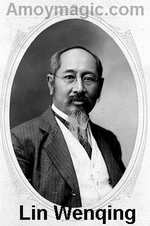
The Sage of Singapore
Dr. Lim Boon-keng/Lin Wenqing (1869-1957), “Sage of Singapore”
Kipling said East and West would never meet, but they did meet in the
2nd presi-dent of Xiamen University, Dr. Lin Wenqing, who was called the
Sage of Singapore by Chinese and foreigners alike. Xiamen University’s
founder, Tan Kak Kee, wrote that Lin was “well versed in Western
materialistic sciences and Chinese cultural spirit.”
Educated first in a Hakka temple and then at Raffles Institution, Lin
was the first Chinese awarded the Queen’s Scholarship, and earned
first class honors in medicine at the University of Edinburgh. But while
Westerners admired Lin, the Chinese at Edinburgh spurned him because of
his poor written and spoken Mandarin Chinese. According to some sources,
English remained his strongest language, and when he gave a speech at
Xiamen University in 1926 he had to use an interpreter! But we know that
he did master at least Minnan Dialect and Cantonese.
In 1905, Lin set up a private hospital for prostitutes and founded the
Anti-Opium Society (ironic, since both his father and China-born grandfather
were opium farmers). Lin excelled at business, particularly the rubber
industry, ship-ping and banking, and helped found the Singapore Chinese
Chamber of Commerce. A pioneer Chinese financier, he partnered with Huang
Yizhu to start the Hefeng Bank and Overseas Chinese Bank. Westerners and
Chinese alike sought the Sage’s wisdom. He was adviser to the British
in the Legislative Council and the Chinese Advisory Board, and attended
the coronations of King Edward VII in 1902 and King George V in 1911.
Lin really showed his colors during World War I when he raised funds for
the Prince of Wales relief fund and for war planes, and in 1918 was awarded
the Order of the British Empire.
In 1900, Lin helped found the Straits Chinese British Association (of
which he was elected president twice). He also started the Chinese “Philomathic”
So-ciety for the study of Chinese language, Western Music, and English
literature, and the Singapore Chinese Girls’ School. And perhaps
because of his own dif-ficulty in mastering Mandarin, he urged that Chinese
children be taught in Mandarin, even going so far as to organize Mandarin
language classes in his own home.
Back to top
Lin was president of Xiamen University from 1921 until 1937, but after
re-turning to Singapore he suffered greatly at the hands of the Japanese,
who tortured his wife to force him into working for them. In 1949, Lin
became the first president of the China Society, and supported that work
until his death on New Year’s day in 1957. He left 3/5 of his estate,
including his Brush Mountain home, to Xiamen University. The estate is
run down nowadays, but still holds a special place in the hearts of those
grateful for this man who wrought great change in the lives of Chinese
both at home and abroad.
Back to top
![]() Favorite
Fujian Sites
Favorite
Fujian Sites ![]() Fujian
Foto Album
Fujian
Foto Album ![]() Xiamen
Xiamen
![]() Gulangyu
Gulangyu
![]() Fujian
Guides
Fujian
Guides ![]() Quanzhou
Quanzhou
![]() Zhangzhou
Zhangzhou
![]() Longyan
Longyan
![]() Wuyi
Mtn
Wuyi
Mtn ![]() Ningde
Ningde
![]() Putian
Putian
![]() Sanming
Sanming
![]() Zhouning
Zhouning
![]() Taimu
Mtn.
Taimu
Mtn. ![]() Roundhouses
Roundhouses
![]() Bridges
Bridges
![]() Jiangxi
Jiangxi
![]() Guilin
Guilin
![]() Order
Books
Order
Books
![]() Readers'
Letters
Readers'
Letters
Last Updated: May 2007
![]()
DAILY
LINKS
![]() FAQs
Questions?
FAQs
Questions?
![]() Real
Estate
Real
Estate
![]() Shopping
Shopping
![]() Maps
Maps
![]() Bookstores
Bookstores
![]() Trains
Trains
![]() Busses
Busses
![]() Car
Rental
Car
Rental
![]() Hotels
Hotels
![]() News
(CT)
News
(CT)
![]() Medical
& Dental
Medical
& Dental
![]() YMCA
Volunteer!
YMCA
Volunteer! ![]()
![]() XICF
Fellowship
XICF
Fellowship
![]() Churches
Churches
![]()
![]() Expat
Groups
Expat
Groups
![]() Maids
Maids
![]() Phone
#s
Phone
#s
EDUCATION
![]() Xiamen
University
Xiamen
University
![]() XIS(Int'l
School)
XIS(Int'l
School)
![]() Study
Mandarin
Study
Mandarin
![]() CSP(China
Studies)
CSP(China
Studies)
![]() Library
Library
![]() Museums
Museums
![]() History
History
DINING
![]() Restaurants
Restaurants
![]() Asian
Asian
![]() Veggie
Veggie
![]() Junk
Food
Junk
Food
![]() Chinese
Chinese
![]() Italian
Italian
![]() International
International![]()
![]() Visas
4 aliens
Visas
4 aliens
RECREATION
![]() Massage!
Massage!
![]() Beaches
Beaches
![]() Fly
Kites
Fly
Kites
![]() Sports
Sports
![]() Boardwalk
Boardwalk
![]() Parks
Parks
![]() Pets
Pets
![]() Birdwatching
Birdwatching
![]() Kung
Fu
Kung
Fu ![]() Hiking
Hiking
![]() Music
Events
Music
Events
![]() Festival&Culture
Festival&Culture
![]() Humor&
Humor&![]() Fun
Fotos
Fun
Fotos![]()
BUSINESS
![]() Doing
Business
Doing
Business
![]() Jobs!(teach/work)
Jobs!(teach/work)
![]() Hire
Workers
Hire
Workers
![]() Foreign
Companies
Foreign
Companies
![]() CIFIT
(Trade Fair)
CIFIT
(Trade Fair)
![]() MTS(Translation)
MTS(Translation)
![]()
Back to Top
